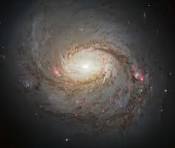Galaxy Classification with Deep Learning
July 9, 2023
🧠 Building a CNN to classify galaxy morphologies using the Galaxy10 dataset
🌀 Project Overview
This project implements a convolutional neural network (CNN) to classify galaxy images into 10 different morphological categories. Using the Galaxy10 dataset from DECaLS (Dark Energy Camera Legacy Survey), I trained a deep learning model to automatically identify galaxy types based on their visual characteristics.
🗂️ Dataset & Methodology
The Galaxy10 dataset contains over 17,000 galaxy images labeled by citizen scientists through the Galaxy Zoo project. Each image is 69×69 pixels and represents one of ten galaxy morphologies:
- Completely round smooth galaxy
- In-between smooth galaxy
- Cigar-shaped smooth galaxy
- Edge-on galaxy (no bulge)
- Edge-on galaxy (with bulge)
- Spiral galaxy
- Galaxy with bar
- Galaxy with no bulge
- Galaxy with just noticeable bulge
- Galaxy with obvious bulge
🧱 Model Architecture
The CNN architecture consists of four convolutional layers with progressively increasing filter sizes, followed by global average pooling and dense layers:
model = tf.keras.Sequential([
tf.keras.layers.Conv2D(32, (3, 3),
activation='relu',
input_shape=(69, 69, 3)),
tf.keras.layers.MaxPooling2D(2, 2),
tf.keras.layers.Conv2D(64, (3, 3),
activation='relu'),
tf.keras.layers.MaxPooling2D(2, 2),
tf.keras.layers.Conv2D(128, (3, 3),
activation='relu'),
tf.keras.layers.MaxPooling2D(2, 2),
tf.keras.layers.Conv2D(256, (3, 3),
activation='relu'),
tf.keras.layers.GlobalAveragePooling2D(),
tf.keras.layers.Dense(128, activation='relu'),
tf.keras.layers.Dropout(0.4),
tf.keras.layers.Dense(10, activation='softmax')
])
🏋️ Training Process
The model was trained for 20 epochs with the following configuration:
- Optimizer: Adam
- Loss Function: Categorical Crossentropy
- Batch Size: 64
- Train/Validation Split: 90/10
- Test Split: 20% of total data
📊 Training Results
The model showed steady improvement throughout training:
- Initial Training Accuracy: 76.04%
- Final Training Accuracy: 88.87%
- Best Validation Accuracy: 72.66%
- Final Test Accuracy: 73.98%
🧪 Implementation Details
🔄 Data Preprocessing
# Load and preprocess Galaxy10 dataset
X, y = galaxy10.load_data()
X = np.array([cv2.resize(img, (69, 69))
for img in X],
dtype='float32') / 255.0
y_cat = tf.keras.utils.to_categorical(y, 10)
🖼️ Model Testing Results
Test Image Analysis
Here's an example of the model in action on a real galaxy image:

Original galaxy image used for testing
📋 Prediction Results

Model prediction output showing classification results
Model Prediction:
- Predicted Class: Spiral galaxy
- Confidence: 46%
- Processing Time: <0.1 seconds
While the confidence is moderate, this reflects the inherent difficulty in galaxy classification, where morphological boundaries can be subtle and subjective even for human experts.
⚙️ Technical Stack
💡 Key Learnings
-
Morphological Classification Complexity: Galaxy classification is inherently challenging due to the continuous nature of morphological features and subjective classification boundaries.
-
Data Augmentation Potential: The model could benefit from data augmentation techniques to improve generalization and handle orientation variations.
-
Transfer Learning Opportunities: Pre-trained models could potentially improve performance, especially given the limited dataset size.
-
Validation Strategy: The relatively stable validation accuracy suggests the model learned meaningful features without excessive overfitting.
🚀 Future Improvements
- Data Augmentation: Implement rotation, scaling, and brightness variations
- Transfer Learning: Experiment with pre-trained CNN backbones
- Ensemble Methods: Combine multiple models for improved accuracy
- Attention Mechanisms: Incorporate attention layers to focus on relevant morphological features
This project was developed using Google Colab and leverages the Galaxy10 dataset, which combines high-quality DECaLS imaging with Galaxy Zoo classifications originally derived from the Sloan Digital Sky Survey (SDSS) project.